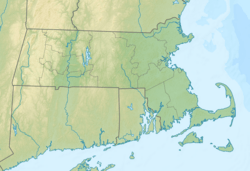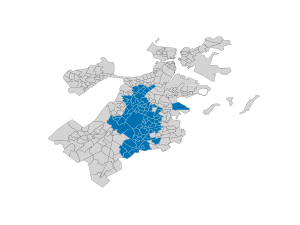Mandela, Massachusetts facts for kids
Quick facts for kids
Mandela County, Massachusetts
|
|
|---|---|
|
Proposed City
|
|
| Country | |
| State | |
| County | Suffolk |
| Region | New England
|
Mandela was a city that people wanted to create by having some neighborhoods break away from Boston, Massachusetts.
These neighborhoods included parts of Roxbury, Dorchester, Mattapan, and the South End. Most people living there were African-American and Latino. Black community leaders led the effort to form this new city.
The name "Mandela" was chosen to honor Nelson Mandela. He was a famous anti-Apartheid activist and political prisoner from South Africa. Later, he became the President of South Africa.
The idea to create Mandela was voted on in 1986 and again in 1988. Both times, the proposal was not approved.
Contents
Why People Wanted a New City
In the summer of 1984, community leaders met to talk about power. They felt that certain communities in Boston did not have enough say. Boston had grown a lot over the years by adding new areas.
Leaders said that Black residents felt like a "colony" of Boston. This was a time when people were discussing community control. Also, it was a decade after big changes in Boston due to school desegregation and busing.
The 1986 Vote on Mandela
The plan for Mandela was to create a new city about 12 square miles big. This new city would be in the middle of Boston. It would include about 22% of Boston's 600,000 people. Most of Boston's Black residents would live there.
The group behind the Mandela idea was called the Greater Roxbury Incorporation Project (GRIP). The main leaders of GRIP were journalist Andrew Philemon Jones and architect Curtis Davis. Mel King, who ran for mayor in 1983, also supported the plan.
Other groups in Boston, like the Dudley Street Neighborhood Initiative (DSNI), also worked on local control for Black and Brown residents.
Andrew Jones believed that Black neighborhoods did not get enough public money from Boston. He said they had a "colonial relationship" with the city.
However, some people were against the idea. These included some Black ministers in Boston, state representative Thomas Finneran, and Mayor Raymond L. Flynn. They argued that a new city would cause problems. They also said it would create a community with a huge money shortage of $135 million each year.
A vote on creating Mandela happened on November 4, 1986. Almost 50,000 people voted. The proposal failed, with 73% of voters saying no. The plan did not win in any area, not even in the neighborhoods that were mostly Black.
The 1988 Vote and Later
The idea to create Mandela was put on the ballot again in 1988. But it was defeated once more.
In 1989, Andrew Jones suggested a new plan. He proposed a commission that would study what would happen if a neighborhood became an independent city.
Years later, in 2017, a group called Epicenter Community held a discussion. They talked about the history of the Mandela movement.
How People Voted
The votes for the Mandela proposal in 1986 and 1988 showed different levels of support.
In 1986, about 12,110 people voted "YES" to create Mandela. About 35,273 people voted "NO". This meant only about 25.6% of voters supported the idea.
In 1988, the support for Mandela grew slightly. About 11,642 people voted "YES", and 21,248 voted "NO". This time, about 35.4% of voters were in favor. Even with more support, the proposal still did not pass.



